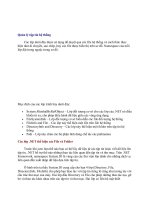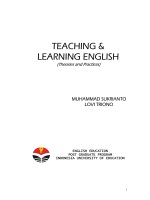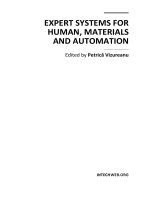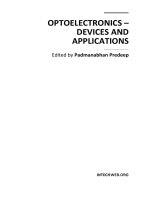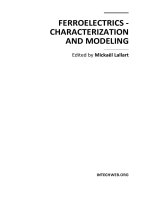Urban Transport and Hybrid Vehiclesedited Part 1 pdf
Bạn đang xem bản rút gọn của tài liệu. Xem và tải ngay bản đầy đủ của tài liệu tại đây (758.67 KB, 20 trang )
Urban Transport
and Hybrid Vehicles
edited by
Seref Soylu
SC I YO
Urban Transport and Hybrid Vehicles
Edited by Seref Soylu
Published by Sciyo
Janeza Trdine 9, 51000 Rijeka, Croatia
Copyright © 2010 Sciyo
All chapters are Open Access articles distributed under the Creative Commons Non Commercial Share
Alike Attribution 3.0 license, which permits to copy, distribute, transmit, and adapt the work in any
medium, so long as the original work is properly cited. After this work has been published by Sciyo,
authors have the right to republish it, in whole or part, in any publication of which they are the author,
and to make other personal use of the work. Any republication, referencing or personal use of the work
must explicitly identify the original source.
Statements and opinions expressed in the chapters are these of the individual contributors and
not necessarily those of the editors or publisher. No responsibility is accepted for the accuracy of
information contained in the published articles. The publisher assumes no responsibility for any
damage or injury to persons or property arising out of the use of any materials, instructions, methods
or ideas contained in the book.
Publishing Process Manager Jelena Marusic
Technical Editor Teodora Smiljanic
Cover Designer Martina Sirotic
Image Copyright icetray, 2010. Used under license from Shutterstock.com
First published September 2010
Printed in India
A free online edition of this book is available at www.sciyo.com
Additional hard copies can be obtained from
Urban Transport and Hybrid Vehicles, Edited by Seref Soylu
p. cm.
ISBN 978-953-307-100-8
SC I YO .C O M
WHERE KNOWLEDGE IS FREE
free online editions of Sciyo
Books, Journals and Videos can
be found at www.sciyo.com
Chapter 2
Chapter 3
Chapter 4
Chapter 5
Chapter 6
Chapter 7
Chapter 8
Chapter 9
Preface VII
Examination of an Urban City Bus Operating Conditions and Emissions 1
Seref Soylu, Ayda Bal, Hülya Semercioglu and Eyup Fatih Ay
Hourly Traffi c Flow Predictions by Different ANN Models 13
Vedat TOPUZ
Local and Global Iterative Algorithms for
Real-Time Short-term Traffi c Flow Prediction 29
Eleni I. Vlahogianni, Ph.D and Matthew G. Karlaftis, Ph.D.
Computer Vision Techniques for Background Modelling
in Urban Traffi c Monitoring 39
José Manuel Milla, Sergio L. Toral, Manuel Vargas and Federico Barrero
Urban Air Quality and Road Traffi c Air Pollution Modelling of Szeged 61
Tamás Weidinger, Györgyi Baranka,
László Makra and András Zénó Gyöngyösi
Optimization of Traffi c Behavior via Fluid Dynamic Approach 103
Ciro D’Apice, Rosanna Manzo and Benedetto Piccoli
Dynamic Modelling and Simulation
of Electrochemical Energy Systems for Electric Vehicles 127
Lucia Gauchia and Javier Sanz
Analysis of the Regenerative Braking System
for a Hybrid Electric Vehicle using Electro-Mechanical Brakes 151
Ki Hwa Jung, Donghyun Kim, Hyunsoo Kim and Sung-Ho Hwang
Control of Electric Vehicle 163
Qi Huang, Jian Li and Yong Chen
Contents
Urban transport system is crucial for economic and social development of our society as
it meets challenging mobility requirements of urban agglomerations. The requirements
are challenging because road transport, which is the most problematic transport mode, is
dominating the urban transport activities. The main problems with the road transport are that
the infrastructure is not generally suffi cient for whole traffi c conditions and the vehicles are
powered by internal combustion engines that require fossil fuels to burn and emit pollutant
emissions during their normal operations.
Internal combustion engines have been used successfully for almost a century as power
source of road transport vehicles, but in the same period vehicle ownership increased to a
level that fi nite fossil fuel resources and environmental and health impact of the emissions
have become great concern for a few decades. There are several regulations to be issued to
promote alternative fuels, however, fuel demand of urban transport vehicles reached to a level
that alternative fuel production levels are far from meeting the demand. On the other hand,
the exhaust emissions are growing concern for especially urban transport vehicles because
these vehicles operate where people normally lives and emit harmful emissions. In the streets
of urban agglomerations, there is not much time and distance for the emissions to be diluted
to a harmless concentration before the emissions are inhaled by human receptors.
This book is the result of valuable contributions from many researchers who work on both
technical and nontechnical sides of the fi eld to be remedy for typical road transport problems.
Many research results are merged together to make this book a guide for industry, academia
and policy makers. I hope you will get maximum benefi t from this book to take the urban
transport system to a sustainable level. As the editor of this book, I would like to express my
gratitude to the chapter authors for submitting such valuable works that most of them already
published or presented in scientifi c journals and conferences.
The chapters of the book are designed in a logical order. It is started with the examination
of typical problems of conventional city busses. Then, an overview of the current state of the
art traffi c fl ow models is presented. It is well known that traffi c fl ow models are vital re-
quirement for advanced traffi c management systems. Finally, hybrid electrical vehicles as an
alternative to the conventional vehicles are examined in details. Hybrid electric vehicles are
expected to be remedy for the minimization of noise, fuel consumption, and pollutant emis-
sions of typical conventional vehicles.
August 12, 2010
Editor
Francisco J. Gallegos-Funes
Sakarya University
Department of Environmental Engineering
Sakarya- TURKEY
Preface
1
Examination of an Urban City Bus Operating
Conditions and Emissions
Seref Soylu, Ayda Bal, Hülya Semercioglu and Eyup Fatih Ay
Sakarya University
Turkey
1. Introduction
City busses are main vehicles for public transport to meet travel demand of the society. They
operate where urban population is very dense and release such emissions as particulate
matters (PM), nitrogen oxides (NOx), carbon monoxides (CO), and hydrocarbons (HC) where
the population lives (Soylu et al., 2009, Gumrukcuoglu et al., 2008, Soylu, 2007, WHO, 2003).
Unfortunately, concentrations of the released emissions are generally high enough to damage
human health and there is no enough time for the emissions to be diluted in the air to harmless
concentrations before they are inhaled by human receptors. It is well known from the literature
that exposure to even relatively low concentrations of vehicle emissions exacerbates or
provokes many diseases (WHO, 2005a, WHO, 2005b). Adverse health effects of the emissions
have been known for many decades and in order to prevent these effects many strict
legislations, which reduces the limits more than 90% over four decades, for vehicle emissions
have been issued. However, urban populations in many developed countries are still suffering
from urban transport sourced emissions (Duclaux, 2002, Colvile et al.,2001, Frey et al., 2009,
Erlandsson et al., 2008). One of the important reasons for this is that the engine certification
test cycles don’t represent the real world in-use operation of the vehicles and, hence, quantity
of vehicle emissions to be released in the urban streets has not been reduced in parallel with
the stringent emission legislations (Cocker et al., 2004, Lents et al., 2007).
City buses generally use diesel engines as power source and emit carbon dioxide (CO
2
),
water vapor (H
2
O), and nitrogen (N
2
) to the ambient air as the main products of engine
combustion. The quantity of CO
2
, which is the major greenhouse gas (GHG), is proportional
to the fuel used in transport activities and it is inevitable combustion product, however, it is
not necessary to emit CO, HC, NOx, and PM, which are generally called local pollutants
since they are more harmful where they are emitted. The emissions of the local pollutants
from city busses depend strongly on engine combustion technology, exhaust after-treatment
devices, fuel quality, vehicle aging, and operating conditions (Cocker et al., 2004, Lents et al.,
2007, Regulation, 2009). Especially the bus operating conditions may have significant effects
on the emissions. Depending on city traffic and road conditions which involves many short
trips with frequent accelerations, decelerations, low rush hour speeds and various road
grades, the emissions may change with an order of magnitude (Cocker et al., 2004).
Urban transport operating conditions and especially the city bus operating conditions are
quite specific for a particular city and, hence, the well known certification test cycles cannot
represent accurately these conditions all over the world. For this reason EURO VI regulation
Urban Transport and Hybrid Vehicles
2
for heavy duty vehicles requires application of portable emissions measurement systems
(PEMS) for verifying the real world in-use and off-cycle emissions (Johnson et al., 2009). PEMS
are remedy for the real world emission measurement as they can be installed quickly to the
vehicle and measure in-use emissions. There are varieties of PEMS available on the market to
measure both gaseous and PM emissions (Lents et al., 2007, Durbin et al., 2007). Some of them
have minor differences in measurement theory and technique that may require
standardization of PEMS themselves in the future (Younglove et al., 2005). With PEMS and
their auxiliary systems it is possible to examine the impacts of road and traffic conditions on
the performance of the vehicle, the engine, the after-treatment system, and the exhaust
emissions. Therefore, it is possible to optimize a vehicle in terms of fuel consumption and
emissions for a specific route by using PEMS. Besides real world emission performance of
advanced technology vehicles such as hybrid vehicles should be tested by using PEMS since
they have an electrical drive unit, also. It is crucial for the automotive industry as
manufacturers and the municipalities as end-users to choose the most suitable vehicle for the
specific transport route to minimize the capital cost, the fuel consumption, and the emissions.
In this sense the PEMS are one of the most useful equipments to meet this need.
PEMS are also very useful in quantification of transport sourced emissions. Since the emissions
factors can be determined under real world conditions, determination of the effects of
transport sourced emission on the global air quality as required by EURO VI can be much
more accurate (Johnson et al., 2009). There have been various research work published in the
literature to examine real-world emission of the vehicles to develop emission factors and
prepare inventory for a vehicle class (Durbin et al., 2007, Younglove et al., 2005, Durbin et al.,
2008, CFR Part 86, 2008). The US EPA and EC JRC have made significant effort for
development of proper methodologies for the real-world in-use emission measurement as a
part of transport emission regulations (Soylu et al., 2009, Southwest Research Institute Report,
2008). The US EPA together with CARB, SENSORS Inc. and Caterpillar Inc. initiated a
programme to develop a mobile emissions laboratory (MEL), which is compliant with code of
federal registration (CFR) 1065, to compare and validate accuracy of PEMS under different in-
use driving conditions (Lents et al., 2007, Durbin et al., 2007, CFR Part 86, 2008, Southwest
Research Institute Report, 2008). At the conclusion of this programme the final measurement
allowance value for NOx emissions determined to be as high as 4.5%.
Swedish Road Administration was also carried out a PEMS programme to test in use
performance of heavy-duty vehicles under real world conditions (Cocker et al., 2004). In this
programme three city busses (which are Euro IV/V level) were equipped with PEMS and
tested on a reference route which comprises urban, rural and highway driving with an average
speed of approximately 60 km/h and on an actual bus route. It was observed that on the actual
bus route, high level transient operation of the city busses have significant adverse effects on
the performance of exhaust after-treatment system. Especially the NOx emissions were
increased almost up to an order of magnitude when compared to that of the reference route.
In Turkey, a similar research project has been introduced by Sakarya University with
support of Turkish Ministry of Industry and TEMSA R&D, to quantify impacts of
hybridization on city bus emissions and fuel consumption under real world in-use
conditions (Soylu, 2009). In order to quantify the impacts, a two-phase test programme was
prepared to measure real world in-use emissions and fuel consumptions of both
conventional and hybrid city busses on a specific bus route in Sakarya city center. In the
present work the results from the first phase of the test programme that involves
Examination of an Urban City Bus Operating Conditions and Emissions
3
examination of the effects of road and traffic conditions on conventional bus operating
characteristics and the response of bus engine and selective catalytic reduction (SCR) system
to these characteristics in terms of NOx emission were presented.
2. Experimental procedures
In this work all the tests were carried out on the “university route” of Sakarya Municipality
city busses. The route includes a round trip between Sakarya University and the city center
which represents typical Sakarya urban driving. It is 22 km long and involves 48 bus stops
and the altitude changes from 30 m to 220 m. The travel time is approximately 60 minutes.
During the test the vehicle was driven on the route with and without its SCR system and
data for vehicle speed and location, engine operation characteristics, exhaust flow-rate,
exhaust emissions and environmental conditions were sampled second by second.
The test measurements were made by using a SEMTECH DS from SENSORS inc. This system
includes a flame ionization detector (FID) for total HC measurement, a non-dispersive infrared
(NDIR) sensor for CO and CO2 measurement, a non-dispersive ultra violet (NDUV) sensor
for NO and NO2 measurement. The NDUV measurement is different from standard
chemiluminescence measurement that is used for the reference method. Exhaust mass flow-
rate was measured by using SEMTECH EFM which operates based on pitot tube technology.
Before the test the PEMS was warmed up according to recommended operating conditions
and then, zero, span and audit calibrations were completed to ensure the accuracy.
The test vehicle was TEMSA AVENUE which is a 12 m long city bus. It is powered with a
6.7 liter engine CUMMINS ISB EURO 4 (model year 2005) engine which produces 250 HP at
2500 rpm. The engine was certified to 3.5 g/kWh NOx standard. Over the test the ambient
temperature varied from 25 to 30 ˚C and the relative humidity varied from 30 to 45 % which
are typical for summer time.
3. Results
Figure 1 indicates a speed profile for the specific test route, which is a real world city bus speed
profile. Highly transient behavior of the route can be seen clearly from the figure. The vehicle
speed reaches to as high as 65 km/h but there are many stops with corresponding
decelerations and accelerations because of the road traffic and bus stops. It is well known
from literature that vehicle speed profile has a strong impact on operating characteristics of the
vehicle engine. Figure 2 indicates the effects of the real world drive characteristics on the
engine map in terms of the number of occurrences (frequency) corresponding to engine loads
and speeds. As can be seen from the figure, under the real world drive conditions the engine
operates most of the time at loads less than 60% and low speed conditions. Figures 3 and 4
indicate engine load-speed map for European Transient Cycle (ETC) that is current regulatory
test cycle for heavy duty engines and World Harmonized Transient Cycle (WHTC) which is
expected to be valid certification cycle for heavy-duty engines with EURO 6 regulation. As can
be seen from the figures in these cycles the engine operates mostly at speeds between 1200 and
1500 rpm and at loads less than 50% except for ETC which also operates frequently at loads
higher than 90% as well. From these maps it is easy to see that the certification test cycles don’t
correlate very well with the real world city bus driving conditions although city bus engines
are still certified according to ETC. WHTC operates more on the low speed conditions but, the
frequencies on the load-speed map are still significantly different from that of the real world
Urban Transport and Hybrid Vehicles
4
city bus driving conditions. It is therefore questionable if the certification cycle emissions limits
ever be realized in the real world driving conditions. A certification test cycle should be able
represent real world operating conditions of an engine, however there are different type of use
of these engines such as highway trucks and busses, delivery trucks, and city busses. Engines
of these different vehicle classes will certainly operate with different frequencies on the engine
load-speed map although they all are certified with the same test cycle. Therefore, off-cycle
operation of these engines and corresponding emissions can be significantly higher than that
of the certification test cycle. In order to minimize these off-cycle emissions, EPA introduced
Not To Exceed (NTE) regulations but there is almost no way to completely control engine
emissions when considering sophistications at engines and their after-treatment systems.
0 200 400 600 800 1000 1200
0
20
40
60
80
Time, seconds
Vehicle speed, km/h
vspeed, test 15
Fig. 1. Variation of the vehicle speed on the specific bus route
Engine speed, rpm
Engine Load, %
750 1000 1250 1500 1750 2000 2250
10
20
30
40
50
60
70
80
90
100
50
100
150
200
250
300
frequency, test 15
Fig. 2. Engine load-speed map for real world driving.
Examination of an Urban City Bus Operating Conditions and Emissions
5
Engine speed, rpm
Engine load, %
750 1000 1250 1500 1750 2000 2250
10
20
30
40
50
60
70
80
90
100
frequency, ETC
10
20
30
40
50
60
Fig. 3. Engine load-speed map for ETC
Engine speed, rpm
Engine load, %
750 1000 1250 1500 1750 2000 2250
10
20
30
40
50
60
70
80
90
100
10
20
30
40
frequency, WHTC
Fig. 4. Engine load-speed map for WHTC (to be valid with EURO 6)
As mentioned earlier, vehicle emissions are strongly dependent on engine operating
conditions. Especially NOx emission formation is almost directly increase with the engine
load since the formation is dependent strongly on combustion temperature and the available
oxygen. As can be seen from Figure 5a and 5b, there are two common strategies to minimize
NOx emissions. First approach is the exhaust gas recirculation (EGR) which minimizes NOx
formation in the engine by lowering the oxygen concentration and maximum combustion
Urban Transport and Hybrid Vehicles
6
Fig. 5a. EGR strategy to minimize NOx emissions (TRAD, 2010).
Fig. 5b. SCR strategy to minimize NOx emissions (VALTRA, 2010).
temperature. However, this approach may have an adverse effect on PM emissions and the
fuel consumptions. The second approach is selective catalytic reduction (SCR) of NOx
emissions which requires a catalyst and aqueous urea solution on the vehicle. Once the urea
solution is injected to hot exhaust gases, NH
3
is formed from the injected urea by means of
hydrolysis. Then NOx emissions are minimized in the catalyst after its chemical reaction
with the NH
3
to form nitrogen and water. SCR of NOx emissions doesn’t have any adverse
effect on fuel consumption and PM emission since the engines can be tuned for maximum
thermal efficiency. However, there are a few other concerns with this approach. First of all,
freezing temperature of the urea solution is quite high, which is -11 ˚C, and this may cause
technical problems during winter time (Koebl, 2000). The second is that high values of NH
3
slip may result if the stoichiometric ratio of NOx to NH
3
cannot be provided. The main
Adblue
tank
Dosing
control
unit
SCR-catal
y
st
Supply
unit
Examination of an Urban City Bus Operating Conditions and Emissions
7
difficulty with this stoichiometry is that engine load and speed are not steady and hence the
concentration of NOx emissions in the exhaust. Therefore establishing the stoichiometry is
mostly dependent on precision of the urea injection control system. The third concern with
SCR system is that it is temperature dependent. In order to reduce the NOx emissions
efficiently, the exhaust gas temperature in the SCR system must be higher than 250 ˚C.
Therefore, the reduction of NOx with SCR system is highly dependent on engine operating
conditions and, hence, vehicle driving conditions.
Figure 6 indicates exhaust gas temperature distribution over the engine load-speed map for
the specific bus route. As can be seen from the figure, the temperature is generally around
250 ˚C over the entire map although there is a tendency that the temperature rises up
through higher loads and speeds. Figure 7 indicates NOx emissions in grams per second to
be released over the engine load-speed map corresponding to the same bus route. As can be
seen from the figure, the NOx emissions increase with the higher speeds and loads because
of the higher combustion temperatures and higher exhaust flow-rates associated with it.
Figure 8 indicates the distribution of the total NOx emissions to be released in grams over
entire trip. As can be seen from the figure during this trip most of the NOx emissions were
released at a location on the map where load is about to 45% and speed is about to 750 rpm,
which are quite low. This seems to be surprising, because as was given in Figure 7, the NOx
emissions in terms of grams per second was increasing with higher loads and speeds.
However, as was given in Figure 2 during the entire trip the engine operating frequency at
45% load and 750 rpm speed was shown about 300 that is one of the most visited locations.
For this reason the total NOx emissions to be released during entire trip is highest at this
location. This location probably corresponds to the city bus idling and first acceleration,
which is visited during every bus stop, for this reason this location is visited most during
the entire trip.
Engine speed, rpm
Engine load, %
750 1000 1250 1500 1750 2000 2250
10
20
30
40
50
60
70
80
90
100
150
175
200
225
250
275
300
325
Tempmatrix, test15
Fig. 6. Exhaust gas temperature distribution (˚C) over engine speed – load map
(Temperature measured from exhaust flow meter).
Urban Transport and Hybrid Vehicles
8
Engine speed, rpm
Engine load, %
750 1000 1250 1500 1750 2000 2250
10
20
30
40
50
60
70
80
90
100
0.05
0.1
0.15
0.2
0.25
0.3
0.35
0.4
NOxmatrix gr/s, test15
Fig. 7. NOx emissions to be released over engine load-speed map without SCR system
Engine speed, rpm
Engine load, %
750 1000 1250 1500 1750 2000 2250
10
20
30
40
50
60
70
80
90
100
5
10
15
20
25
30
35
NOx matrix (gr), test15
Fig. 8. Cycle NOx emissions to be released over engine load-speed map without SCR system
Figure 9 indicates another trip on the same route while SCR system of the city bus is active.
As can be seen from the figure, NOx emissions to be released over the entire map are much
less than that of the trip without SCR system, which is Figure 7. NOx emissions are
efficiently reduced exceptions for a few hot spots. Besides, there is no step wise increase in
NOx emissions with increasing load and speed exception for loads higher than 90%. At this
load and speed the exhaust mass flow-rate is probably so high that the NOx emissions in
grams per second are still significant. Figure 10 indicates the total NOx emissions to be
released for the entire trip while SCR system is active. As can be seen from the figure the
Examination of an Urban City Bus Operating Conditions and Emissions
9
Engine speed, rpm
Engine load, %
750 1000 1250 1500 1750 2000 2250
10
20
30
40
50
60
70
80
90
100
0.05
0.1
0.15
0.2
0.25
NOxmatrix gr/s, test10
Fig. 9. NOx emissions to be released over engine load-speed map with SCR system.
Engine speed, rpm
Engine load, %
750 1000 1250 1500 1750 2000 2250
10
20
30
40
50
60
70
80
90
100
2
4
6
8
10
12
14
16
NOx matrix (gr), test10
Fig. 10. Cycle NOx emissions to be released over engine load-speed map with SCR system.
Urban Transport and Hybrid Vehicles
10
most of the NOx emissions are released at 25% load and 750 rpm speed. This location is the
idling location and as was given in Figure 2, it is one of the most visited locations during the
entire trip on this route. For this reason, the total NOx emissions to be released during the
entire trip are highest at this location.
These figures indicates that city busses that operate in the bus routes are generally operating
at low loads and speeds and most of the trip emissions are corresponding to these locations
on the map.
4. Conclusions
It was observed that real world driving characteristics of the city bus don’t correlate well
with that of the ETC, which is the certification cycle for the city bus engines. For this reason
it is not realistic to expect emission levels lower than corresponding EURO standards from
the city bus during real world driving. City bus NOx emissions in terms of grams per
second are increasing with engine load and speed but the total NOx emissions for entire trip
are the maximum at the locations where engine visited most, which are low speed and load
conditions. Therefore, while optimizing the city buses for the best fuel economy and
emissions, the real world drive characteristics of the city bus and the corresponding
operating conditions of the engine and after-treatment system must be considered.
5. Acknowledgment
TEMSA R&D and Turkish Ministry of Industry and Trade are acknowledged for their
contribution to this work.
6. References
[1] Soylu, S.; Gumrukcuoglu, M; Senturk, G.; Bal, A.; Aydınlar, B. (2009). Examination Urban
Transport Activities And Emissions, Adapazarı Case Study, the 17
th
transport and air
Pollution Symposium and the third Environment and Transport Symposium, June 2-4,
2009 Toulouse, France
[2] Gümrükçüoğlu M.; Soylu S. (2008). Monitoring of urban transport sourced pollutants by
using GIS, 5th International Conference on Geographic Information Systems, July 2-5,
2008, Istanbul-Turkey
[3] Soylu, S. (2007). Estimation of Turkish Road Transport Emissions, Energy Policy 35 (2007)
4088–4094, April 2007.
[4] WHO, 2003. Health aspects of air pollution with particulate matter, ozone, and nitrogen
dioxide. Report on a WHO Working Group, Germany, 2003. www.who.int/en
[5] WHO, 2005a. Air quality guidelines for Europe; second edition Copenhagen. WHO
Regional Office for Europe, WHO Regional Publications. European series; No 91.
www.euro.who.int/air/activities/20050223_4
[6] WHO, 2005b. Health effects of transport-related air pollution. WHO Regional Office for
Europe Scherfigsvej 8, DK-2100 Copenhagen , Denmark
[7] Duclaux, O.(2002). 3D-air quality model evaluation using the Lidar technique.
AtmosphericEnvironment, 2002- 36(32), 5081-5095.
Examination of an Urban City Bus Operating Conditions and Emissions
11
[8] Colvile, R.N., Hutchinson, E.J., Mindell, J.S., Warren, R.F. (2001). The transport sector as a
source of air pollution. Atmospheric Environment 2001-35, 1537–1565.
[9] Frey, H. C.; Zhai, H. & Rouphail, N. M. (2009). Regional On-Road Vehicle Running
Emissions Modeling and Evaluation for Conventional and Alternative Vehicle
Technologies. Environmental Science & Technology 2009- 43, 8449–8455
[10] Erlandsson, L.; Almen, J, & Johansson, H. (2008). Measurement of emissions from heavy
duty vehicles meeting Euro IV/V emission levels by using on-board measurement
in real life operation. 16
th
International Symposium ’Transport and Air Pollution
[11] Cocker III, D. R.; Sandip, D. S.; Johnson, K.; Miller, J . W. & Norbeck, J. M. (2004).
Development and Application of a Mobile Laboratory for Measuring Emissions
from Diesel Engines. 1. Regulated Gaseous Emissions. Environmental Science
&Technology 2004- 38, 2182-2189
[12] Lents, J.; Unal, A.; Mangir, N.; Osses, M.; Tolvett, S. & Yunusoglu, O. (2007). A study of
the emissions from diesel vehicles operating in Istanbul, Turkey
[13] Regulation, (2009). EC Regulation No 595/2009 of the European Parliament and of the
Council 18 June 2009
[14] Johnson , K.C.; Durbin, T.D.; Cocker III, D.R.; Miller, W.J.; Bishnu, D.K.; Maldonado, H;
Moynahan, N.; Ensfield, C. & Laroo, C.A. (2009). On-road comparison of a portable
emission measurement system with a mobile reference laboratory for a heavy-duty
diesel vehicle. Atmospheric Environment 43 (2009) 2877–2883
[15] Durbin, T.D. & Johnson, K. (2007). Evaluation and Comparison of Portable Emissions
Measurement Systems and Federal Reference Methods for Emissions from a Back-
Up Generator and a Diesel Truck Operated on a Chassis Dynamometer.
Environmental Science & Technology 2007-41, 6199-6204
[16] Younglove, T.; Scora, G. & Barth, M. (2005). Designing on-road vehicle test programs for
effective vehicle emission model development. Revised for Transportation Research
Record
[17] Durbin, T.D.; Johnson, K.; Miller, J.W.; Maldonado, H. & Chernich, D. (2008). Emissions
from heavy-duty vehicles under actual on-road driving conditions. Atmospheric
Environment 42 (2008) 4812–4821
[18] CFR Part 86, (2008). In-Use Testing for Heavy-Duty Diesel Engines and Vehicles;
Emission Measurement Accuracy Margins for Portable Emission Measurement
Systems and Program Revisions, EPA, 40 CFR Part 86, Federal Register / Vol. 73,
No. 50 / Thursday, March 13, 2008 / Rules and Regulations
[19] Southwest Research Institute Report, (2008). Determination of PEMS Measurement
Allowances for Gaseous Emissions Regulated Under the Heavy-Duty Diesel Engine
In-Use Testing Program, Assessment and Standards Division Office of
Transportation and Air Quality U.S. Environmental Protection Agency, Prepared
for EPA by Southwest Research Institute EPA Contract No. EP-C-05-018, February
2008
[20] Soylu, S. (2009). Measurement and Modelling of Hybrid City Bus Emissions under Real
world Conditions, SANTEZ Project 6th month report, Sakarya University, TURKEY
Urban Transport and Hybrid Vehicles
12
[21] Koebl, M.; Elsener, M. & Kleeman, M. (2000). Urea-SCR: a promising technique to
reduce NOx emissions from automotive diesel engines, Catalysis Today 59 (2000)
335–345.
[22] TRAD, (2010).
[23] VALTRA, (2010).
